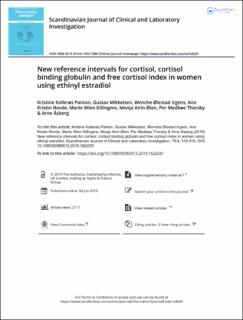| dc.contributor.author | Panton, Kristine Kollerøs | |
| dc.contributor.author | Mikkelsen, Gustav | |
| dc.contributor.author | Irgens, Wenche Elna Øiestad | |
| dc.contributor.author | Hovde, Ann Kristin | |
| dc.contributor.author | Killingmo, Marte Wien | |
| dc.contributor.author | Øien, Monja Airin | |
| dc.contributor.author | Thorsby, Per Medbøe | |
| dc.contributor.author | Åsberg, Arne | |
| dc.date.accessioned | 2021-04-27T07:24:36Z | |
| dc.date.available | 2021-04-27T07:24:36Z | |
| dc.date.created | 2019-09-14T13:37:35Z | |
| dc.date.issued | 2019 | |
| dc.identifier.citation | Scandinavian Journal of Clinical and Laboratory Investigation. 2019, 79 (5), 314-319. | en_US |
| dc.identifier.issn | 0036-5513 | |
| dc.identifier.uri | https://hdl.handle.net/11250/2739760 | |
| dc.description.abstract | Healthy women using contraceptives containing a low dose of an estrogen may have a higher serum concentration of cortisol (s-cortisol) and cortisol binding globulin (s-CBG) than the commonly used upper reference limits. There are no published reference intervals for s-cortisol, s-CBG, serum free cortisol index (s-FCI) or cortisol in saliva (sa-cortisol) for these women. The aim was to establish the above-mentioned reference intervals and document the differences in s-cortisol and s-CBG in one group of women using and another group not using ethinyl estradiol (EE). In this cross-sectional study, the reference limits presented were given as the 2.5 and 97.5 percentiles of the distribution of reference values in a population of 277 healthy volunteer women, aged 18–45 years. 157 women were not using any type of estrogen, while 120 women were using contraceptives containing a daily dose of 15–35 μg of EE. Serum and salivary cortisol, and serum CBG were measured using standard laboratory methods. S-FCI was calculated as s-cortisol/s-CBG. The reference intervals for s-cortisol in samples collected at 0800–1030 am in women using and not using EE contraception were: 284–994 nmol/L and 159–569 nmol/L respectively, and for s-CBG: 847–3366 nmol/L and 860–1940 nmol/L, respectively. For s-FCI and sa-cortisol, no clinically significant differences were found. Sa-cortisol may be the preferred measurand for evaluation of possible hypercortisolism in women using estrogens, since cortisol in saliva is not influenced by estrogen. If assessing morning s-cortisol and s-CBG in women using EE, we recommend using separate – and not the commonly used – reference intervals. | en_US |
| dc.language.iso | eng | en_US |
| dc.publisher | Taylor & Francis | en_US |
| dc.rights | Attribution-NonCommercial-NoDerivatives 4.0 Internasjonal | * |
| dc.rights.uri | http://creativecommons.org/licenses/by-nc-nd/4.0/deed.no | * |
| dc.title | New reference intervals for cortisol, cortisol binding globulin and free cortisol index in women using ethinyl estradiol | en_US |
| dc.type | Peer reviewed | en_US |
| dc.type | Journal article | en_US |
| dc.description.version | publishedVersion | en_US |
| dc.source.pagenumber | 314-319 | en_US |
| dc.source.volume | 79 | en_US |
| dc.source.journal | Scandinavian Journal of Clinical and Laboratory Investigation | en_US |
| dc.source.issue | 5 | en_US |
| dc.identifier.doi | 10.1080/00365513.2019.1622031 | |
| dc.identifier.cristin | 1724688 | |
| cristin.ispublished | true | |
| cristin.fulltext | original | |
| cristin.qualitycode | 1 | |

